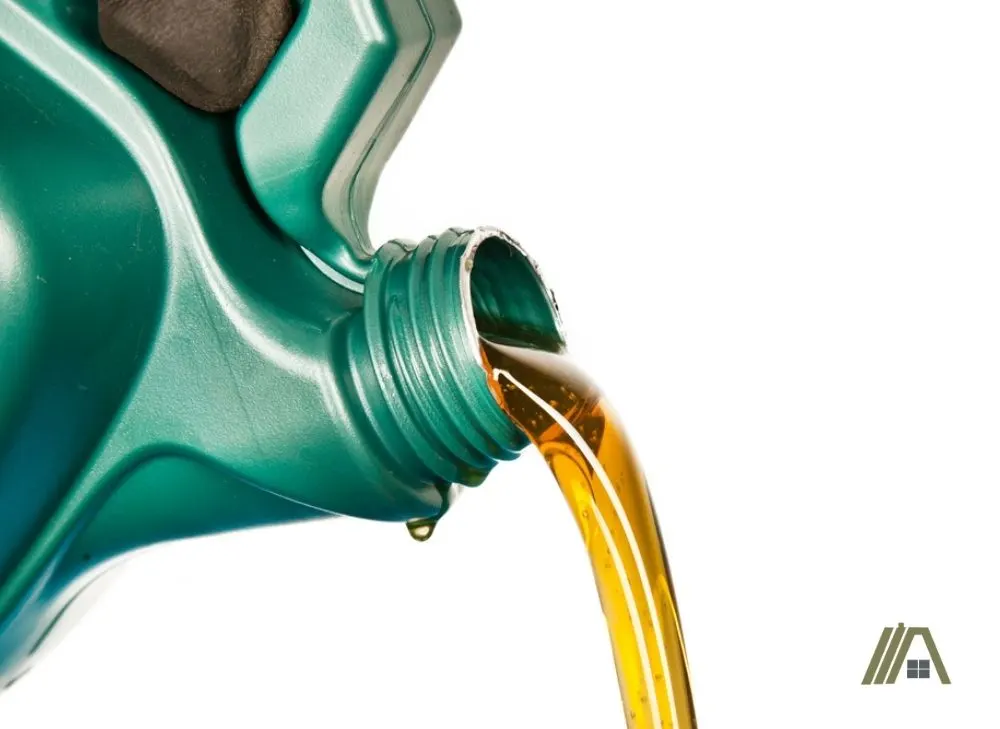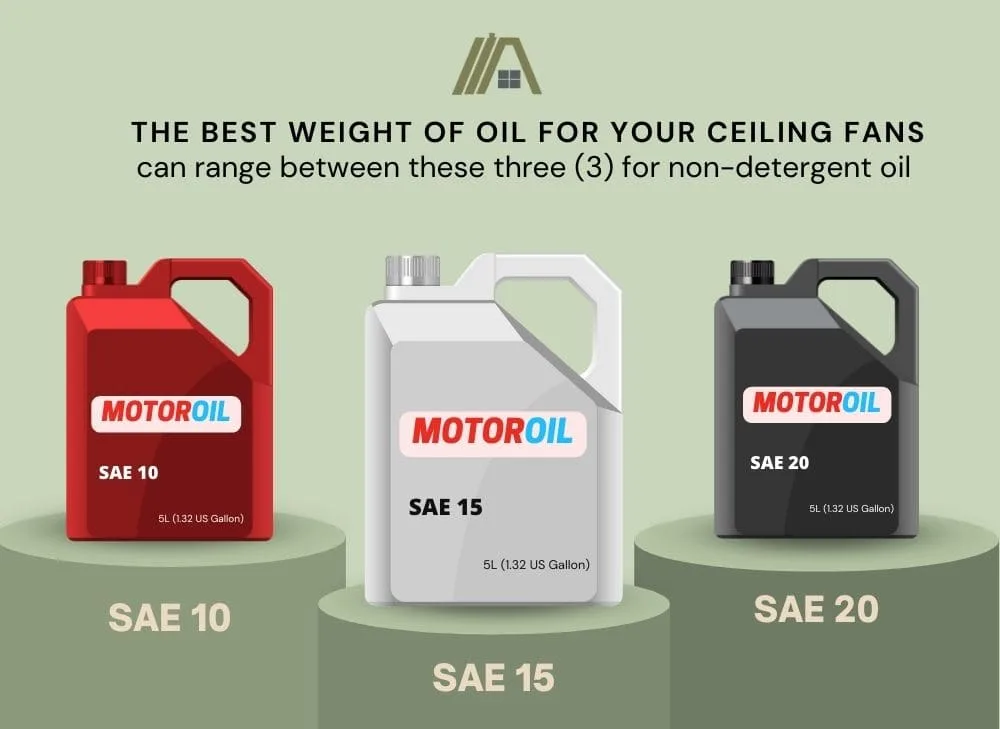Ceiling fans are one of the great ways you can cool your home in those hot summer nights. They are also often more stylish than the alternatives, like box or pedestal fans. Like all mechanical and electrical devices, some maintenance is required to keep a ceiling fan functioning optimally.
One part of maintenance is lubricating the motor bearings. But you can’t just use any oil for this. This article is not just about which oil is best to use. We also look at which ones you should steer well clear of.

The best oil for lubricating a ceiling fan is a non-detergent motor oil with an SAE number (viscosity rating) of 10, 15, or 20. However, always check the manufacturer’s instructions for their recommendations.
How Does Ceiling Fan Lubrication Work?
Not all ceiling fans need to be oiled. If yours does, then there will be a small oil hole somewhere in the motor housing. You will add oil to this hole as per the manufacturer’s instructions and, as the hole leads to the moving motor bearing, this process lubricates them without direct access. You don’t even have to take the fan down to do this.
Lubrication is important to prevent the moving parts from rubbing against the non-moving parts of the fan motor. This would create noise and excess heat and the parts would wear down and lose functionality.
Some ceiling fans, especially newer models, don’t need lubrication as they have sealed, self-lubricating bearings. These are impregnated with a lubricant.
Only Use Non-Detergent Oils
Detergent oils contain detergent additives or ingredients that trap and breakdown contaminants. They are good for cleaning mechanical equipment but because of their propensity to collect dirt, when used as a lubricating oil, they can create a sludgy buildup on the bearings, impeding their movement and placing strain on the ceiling fan motor.
Non-detergent oils do not contain such detergent additives and, thus, these effects are avoided. The oil is able to coat the bearings without gumming them up and that is why these types of oils are highly recommended for ceiling fan use.
Motor Oils Are the Best
It is best to read the manufacturer’s recommendations as to what type of oils should and can be used to lubricate your ceiling fan motor. It needs to be an oil that suits electric motors.

Non-detergent motor oil is a great lubricant, specifically designed for use with electric motors. Let’s look at how this oil compares to other types that you may look at using in your fan motor and which would not serve the purpose as well as motor oil.
- 3 in 1 oils – These are very light oils, making them inadequate lubricants for bearings. Poor lubrication means greater friction and excess heat production. While 3 in 1 oils are not flammable, they are combustible over 305 °F (151.7 °C). Such temperatures are unlikely to be reached in a ceiling fan motor, but it still presents a greater fire risk than motor oil (not combustible), particularly in light of the friction-based heat production.
- Cooking oils – Cooking oil is not meant to be used within machines. It eventually dries up and creates a sticky and cakey residue which prevents the bearings from moving smoothly. You’ve seen the greasy mess of your cabinets nearest the stovetop; this is what happens to the bearings. In addition, cooking oils are highly flammable.
- Baby oil – If you are a parent, then you can use baby oil as a last resort. It is non-conductive and a lot safer to use than the above two options. It won’t last as long as motor oil, but at least it’ll stop the squeaking for the night before you can get to the store.
- Mineral oils – Most mineral oils are also non-conductive and can be used in a pinch, but you will need to oil your fan more often and you should not make a habit of using this.
There may be different lubricating substitutes, but motor oil is the most effective and safest oil to use at the end of the day because of its suitability to the task, longevity, and ease of use.
Longevity
As mentioned, oils like baby oil and mineral oil can be used, however, only for short periods of time. These oils are much thinner than the oil you need for a motor bearing. So, they will do the job in a pinch, but they are not going to prove to be a long-lasting solution. Within a few hours or days, the motor bearings will become stiff again.
This also means that you would have to reapply the oil far more often and use much more of it than if you simply used a motor oil, which would only need replenishing every 6-12 months.
Ease of Use
Not only are motor oils more suited to the task of motor bearing lubrication than baby or mineral oils, but it is just easier to work with. Motor oils generally have a higher viscosity and will pour out more slowly than the other oils, making it less of a messy application.
What Grade of Oil to Use?
Motor oil is not just motor oil. It is divided into grades based on the weight and viscosity (the easiness at which the oil flows at a certain temperature). The grade of motor oil that is meant for your fan should be located in your user manual and will likely be represented as an SAE number.
The lower the SAE number, the more viscous the oil. The best weight of oil for your ceiling fans can range between SAE 10, 15, and 20 for non-detergent oil.

When the oil used is too thick, it can make it difficult for the bearings to move freely at their desired speed, gumming them up as opposed to lubricating them.
Avoid Penetrating Oils
Penetrating oils have a very low viscosity (extremely fluid and lightweight) and are super volatile. They can evaporate quickly and won’t be suitable as a lubricant for long periods of time.
This is why WD-40 is not recommended to lubricate ceiling fans and other appliances like dryers. It may be a good quick go-to for lubricating rusted screws and hinges, but not for bearings that are constantly in motion and need well-graded lubrication.
Listen to Manufacturers’ Recommendations
Ceiling fans may look very similar, but they do vary in motor size. Some fans may have a higher horsepower than others, which will play a role in what type of oil is most suitable at the end of the day. Thicker oils may be used for motors with higher horsepower compared to thinner oils.
This is why it is best to check the manufacturer’s instructions for which oil to use.
For example, the Hunter Fan Company recommends using SAE 10 non-detergent oil on their Hunter Original ceiling fan.
Some manufacturers don’t even oil type as their fans are permanently lubricated like the Infinite Breeze’s direct current ceiling fan. Most fan models are manufactured this way these days.
Sources
https://images.homedepot-static.com/catalog/pdfImages/39/395d063c-9d61-471b-93c3-d8d4b748ee06.pdf
https://diequa.com/blog/the-advantages-of-sealed-bearings/
https://www.sidmartinbio.org/what-is-non-detergent-sae-30/
https://airflowacademy.com/oil-a-ceiling-fan/
https://web.faa.illinois.edu/app/uploads/sites/6/2021/05/3-IN-ONE-Multi-Purpose-Oil.pdf
https://dictionary.cambridge.org/dictionary/english/flashpoint
https://www.fancollectors.org/info/Lubrication.htm
https://en.wikipedia.org/wiki/Penetrating_oil

